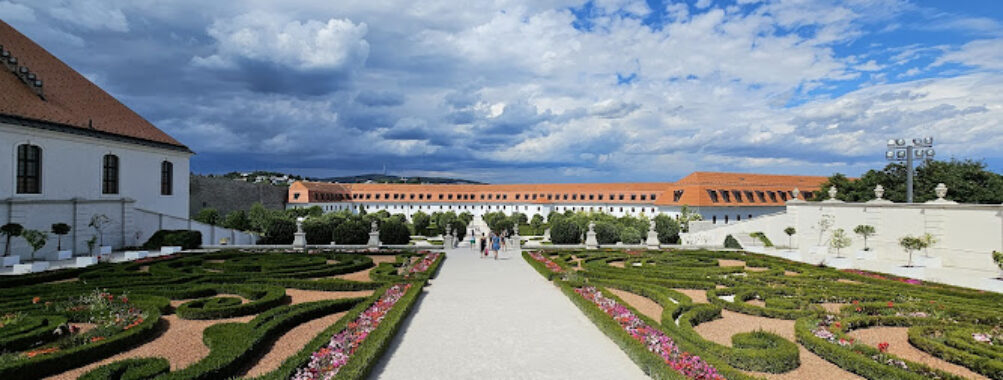
Baroque garden
“`html
Table of Contents
Description
There’s something about a Baroque garden that feels almost theatrical. It’s not just a garden—it’s a stage where nature and geometry perform in perfect harmony. The Baroque garden in Bratislava is no exception. It’s a place where precision, symmetry, and artistry collide, creating a living masterpiece that tells stories of grandeur and human ambition. Walking through its manicured parterres and sculpted hedges, one can almost hear the faint echo of courtly footsteps from centuries past.
The garden’s design follows the classic Baroque principles that first blossomed in Italy and later spread across Europe. Think of long, straight avenues that draw your eye to a central focal point—perhaps a fountain, a statue, or a grand palace façade. Everything here feels intentional, as if each flowerbed and gravel path were part of a grand architectural plan. And honestly, they were. The Baroque garden was meant to impress, to showcase control over nature, and to reflect the power and sophistication of the era’s elite.
Yet despite its formal structure, there’s warmth and charm here too. Families stroll along the paths, kids giggle near the playground, and travelers pause under the shade of ancient trees. It’s not just a relic of the past—it’s a living, breathing space that continues to delight visitors. Sure, on busy days it can get a bit crowded, and some areas show the wear of time, but that almost adds to its authenticity. It’s real, layered, and full of stories.
Key Features
- Geometric Precision: Perfectly aligned paths and symmetrical layouts that reflect the essence of Baroque design.
- Fountains and Sculptures: Elegant stone fountains and mythological statues that add drama and artistry to the landscape.
- Terraced Views: Elevated sections offering sweeping views of the surrounding city and castle grounds.
- Accessibility: The garden is wheelchair accessible, making it enjoyable for visitors of all abilities.
- Family-Friendly: With open lawns, a playground, and kid-friendly walking trails, it’s a great spot for families.
- Rest Areas: Benches and shaded nooks perfect for resting or simply people-watching.
- Seasonal Blooms: From spring tulips to autumn foliage, the garden transforms beautifully throughout the year.
One of my favorite things about this place is how it balances grandeur with simplicity. You can marvel at the ornate details of a marble statue one moment and then find yourself quietly admiring a butterfly landing on a lavender bush the next. That’s the magic of it—it’s both majestic and intimate.
Best Time to Visit
If you ask me, spring and early autumn are the sweet spots. In spring, the garden bursts into color—rows of tulips, daffodils, and other early blooms paint the grounds with life. The air smells faintly of earth and blossoms, and the weather is just right for long, lazy walks. Autumn, on the other hand, brings a completely different charm. The leaves turn shades of gold and crimson, and there’s a crispness in the air that makes the garden feel almost cinematic.
Summer can be lovely too, especially if you don’t mind the heat and the occasional crowd. Families often come out for picnics, and there’s a lively buzz that fills the space. Winter is quieter—some might say too quiet—but if you enjoy peaceful strolls and want photos without people in the background, it’s worth a visit. Just bundle up; the wind can be brisk.
How to Get There
Reaching the Baroque garden is quite straightforward. Most travelers arrive from the city center, and the walk itself is part of the experience. The route winds uphill through charming old streets, and before you know it, the garden opens up before you like a green oasis. If walking isn’t your thing, local buses and taxis can drop you nearby, and there’s usually parking available within a short distance.
Personally, I’d recommend walking if you can. There’s something special about approaching the garden on foot—the gradual reveal of terraces, the sound of birds, and that first glimpse of the castle above. It feels earned, like you’ve stepped back in time just a little.
Tips for Visiting
Here’s where a bit of insider advice comes in handy. Having visited more times than I can count, I’ve learned a few things that might make your trip smoother—and more enjoyable.
- Go early or late in the day: The light is softer, the crowds thinner, and the photos far better.
- Wear comfortable shoes: The gravel paths and gentle slopes can surprise you if you’re in flimsy footwear.
- Bring water and snacks: There are restrooms on-site, but refreshments can be limited depending on the season.
- Take your time: Don’t rush through. Sit on a bench, listen to the fountains, and let the atmosphere sink in.
- Look for hidden details: Some of the smaller sculptures and carvings are easy to miss—they’re tucked into corners or behind hedges.
- Visit during a weekday: Weekends can get quite busy, especially when the weather’s nice.
One time, I remember sitting near a fountain just as the sun dipped low behind the castle. The whole garden glowed in a golden hue, and for a moment, it felt like time had stopped. It’s those little moments that make this place unforgettable.
For travelers who love history, architecture, or simply beautiful outdoor spaces, the Baroque garden offers a rare chance to step into another era while still feeling very much in the present. It’s a place that rewards curiosity—every path, every statue, every carefully trimmed hedge has a story to tell. And if you listen closely, you might just hear it.
“`
Location
Places to Stay Near Baroque garden
Find and Book a Tour
Explore More Travel Guides
No reviews found! Be the first to review!